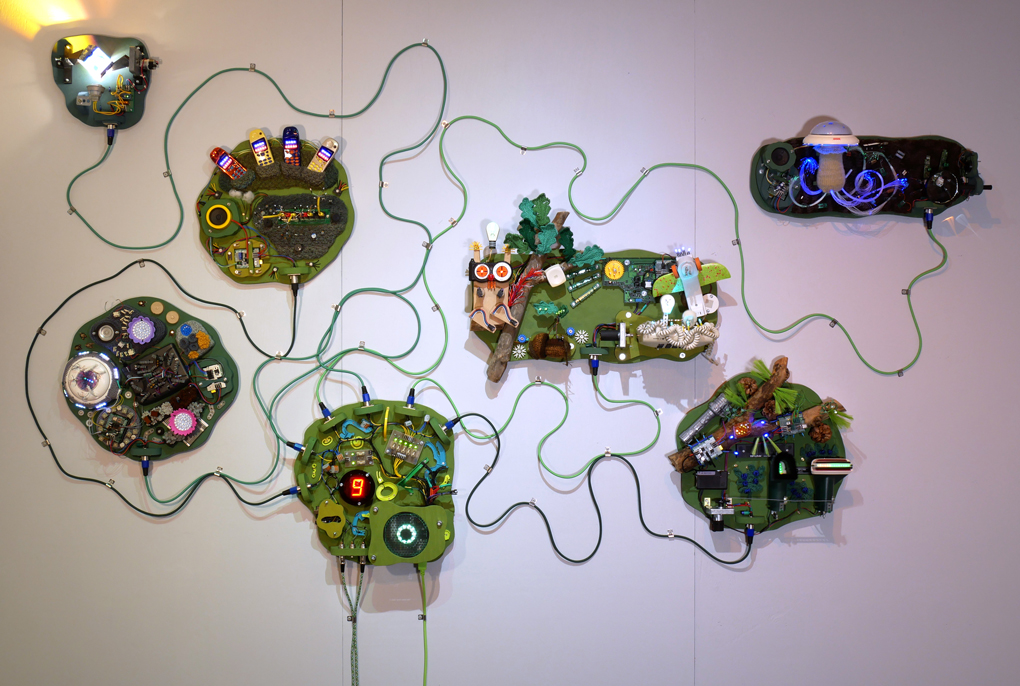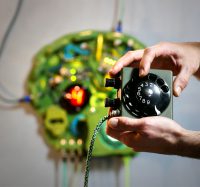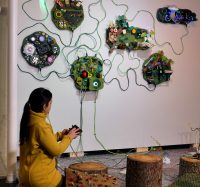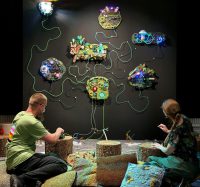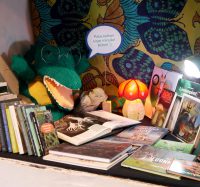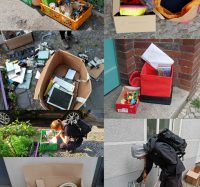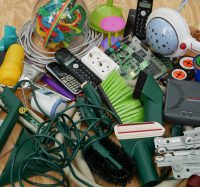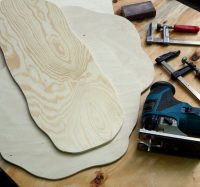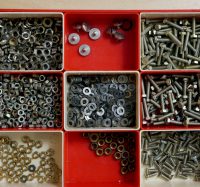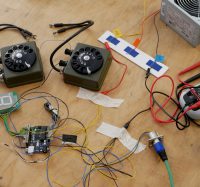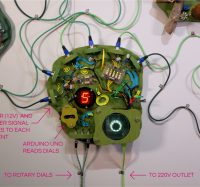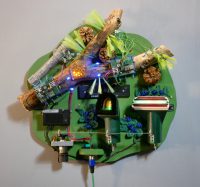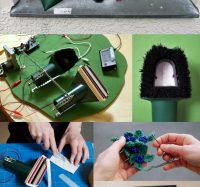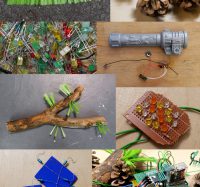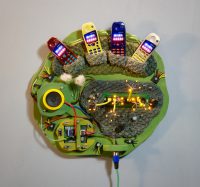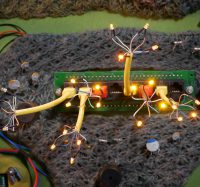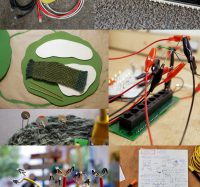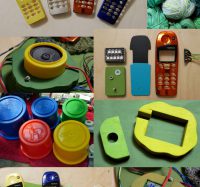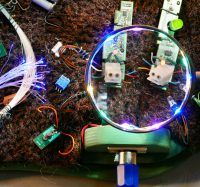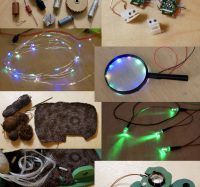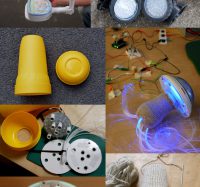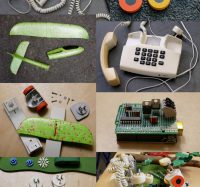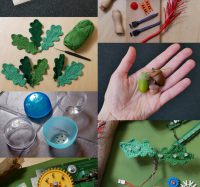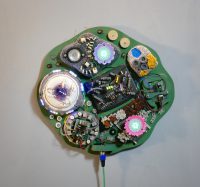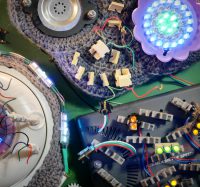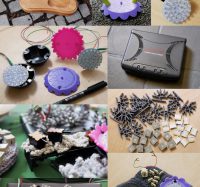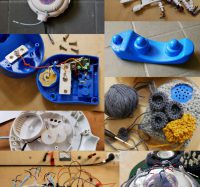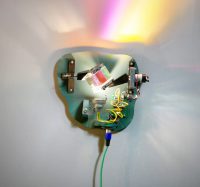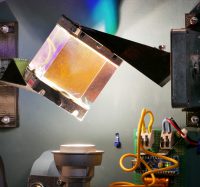Call the Forest
Interactive installation
Touring children's exhibition, Finland / 2020-22
Call the Forest (Haloo, kuuleeko metsä?) is an interactive installation made for a children’s touring exhibition. The installation invites exhibition visitors to call a constructed forest scenery, offering also a possibility to contemplate our relationship with nature and technology. The exhibition was produced by Käsityökoulu Robotti, a Finnish non-profit art and craft school focusing on electronic arts, and funded by the Arts Promotion Centre Finland.
The installation was inspired by old, dark green rotary dials of Swedish field telephones. These military communication devices, which had resided in my DIY boxes for a while, found a peaceful purpose as a part of the installation’s imaginary forest. Since we connect with other humans through various gadgets and channels all the time, what if we called the forest for a change? The installation consists of different kinds of forest elements, which are hung on the wall. By dialling a number (0-9), it is possible to discover micro-scenes in the elements, including sound, light and movement. For example, in the bog a cross-breed of sundew and abandoned network cables is luring tiny bugs, while in the soil a fungal web made of optic fibres twinkles.
The installation was built largely from found objects, which I collected from the streets of my hometown, Berlin. Additionally, obsolete communication technologies and related parts were used, such as old rotary telephone parts and mobile phone covers. The shapes and properties of these objects have given form to the forest’s characters. It remains a mystery whether nature has taken over the junk, or vice versa. When implementing the work, I have put effort in making it repairable and easy to disassemble into its atoms. So, one day, when the installation reaches the end of its life, hopefully the materials will continue their circulation in upcoming projects, as a part of the creative cycle.
In addition to the installation, the children’s touring exhibition includes a small nature library as well as workshops and playful exercises for children, which relate to the themes of nature, technology and communication. More information about the exhibition on the website of The Association of Finnish Children’s Cultural Centers (in Finnish). We had our first exhibition in 2020 at the Children’s Cultural Centre Aurora in Espoo. Call the Forest has also been shown at Annantalo Arts Centre in Helsinki (2021), Kita – House of Kinetic Arts in Joutsa (2022) and Children’s Cultural Centre Kruunupää in Pori (2022). During spring 2023 you can call the forest at ARX – Open Cultural Centre in Hämeenlinna (Finland).
I warmly thank Käsityökoulu Robotti, Children’s Cultural Centre Aurora and the Arts Promotion Centre Finland for making this project possible. Special thanks to Niklas Roy for helping out with the implementation of the installation and to Sara Milazzo, the producer of the exhibition, with whom it was a great pleasure to work. Further thank you to my mother Pirjo for making great pillows and to publishers Gummerus and Otava for donating books for the exhibition. Thank you also to In the Yarn Garden for the beautiful oak leaf crochet pattern.
Call the Forest (Haloo, kuuleeko metsä?) is an interactive installation made for a children’s touring exhibition. The installation invites exhibition visitors to call a constructed forest scenery, offering also a possibility to contemplate our relationship with nature and technology. The exhibition was produced by Käsityökoulu Robotti, a Finnish non-profit art and craft school focusing on electronic arts, and funded by the Arts Promotion Centre Finland.
The installation was inspired by old, dark green rotary dials of Swedish field telephones. These military communication devices, which had resided in my DIY boxes for a while, found a peaceful purpose as a part of the installation’s imaginary forest. Since we connect with other humans through various gadgets and channels all the time, what if we called the forest for a change? The installation consists of different kinds of forest elements, which are hung on the wall. By dialling a number (0-9), it is possible to discover micro-scenes in the elements, including sound, light and movement. For example, in the bog a cross-breed of sundew and abandoned network cables is luring tiny bugs, while in the soil a fungal web made of optic fibres twinkles.
The installation was built largely from found objects, which I collected from the streets of my hometown, Berlin. Additionally, obsolete communication technologies and related parts were used, such as old rotary telephone parts and mobile phone covers. The shapes and properties of these objects have given form to the forest’s characters. It remains a mystery whether nature has taken over the junk, or vice versa. When implementing the work, I have put effort in making it repairable and easy to disassemble into its atoms. So, one day, when the installation reaches the end of its life, hopefully the materials will continue their circulation in upcoming projects, as a part of the creative cycle.
In addition to the installation, the children’s touring exhibition includes a small nature library as well as workshops and playful exercises for children, which relate to the themes of nature, technology and communication. More information about the exhibition on the website of The Association of Finnish Children’s Cultural Centers (in Finnish). We had our first exhibition in 2020 at the Children’s Cultural Centre Aurora in Espoo. Call the Forest has also been shown at Annantalo Arts Centre in Helsinki (2021), Kita – House of Kinetic Arts in Joutsa (2022) and Children’s Cultural Centre Kruunupää in Pori (2022). During spring 2023 you can call the forest at ARX – Open Cultural Centre in Hämeenlinna (Finland).
I warmly thank Käsityökoulu Robotti, Children’s Cultural Centre Aurora and the Arts Promotion Centre Finland for making this project possible. Special thanks to Niklas Roy for helping out with the implementation of the installation and to Sara Milazzo, the producer of the exhibition, with whom it was a great pleasure to work. Further thank you to my mother Pirjo for making great pillows and to publishers Gummerus and Otava for donating books for the exhibition. Thank you also to In the Yarn Garden for the beautiful oak leaf crochet pattern.
